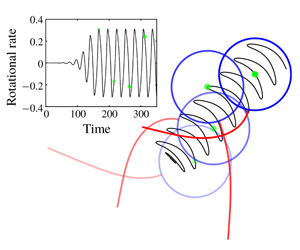Crossref Citations
This article has been cited by the following publications. This list is generated based on data provided by
Crossref.
Liu, Zhaorong
Qin, Fenghua
Zhu, Lailai
Yang, Runhuai
and
Luo, Xisheng
2020.
Effects of the intrinsic curvature of elastic filaments on the propulsion of a flagellated microrobot.
Physics of Fluids,
Vol. 32,
Issue. 4,
Liu, Zhaorong
Qin, Fenghua
and
Zhu, Lailai
2020.
Actuating a curved elastic filament for bidirectional propulsion.
Physical Review Fluids,
Vol. 5,
Issue. 12,
Zou, Zonghao
Lough, Wilson
and
Spagnolie, Saverio
2021.
Helical trajectories of swimming cells with a flexible flagellar hook.
Physical Review Fluids,
Vol. 6,
Issue. 10,
Qin, Ke
Peng, Zhiwei
Chen, Ye
Nganguia, Herve
Zhu, Lailai
and
Pak, On Shun
2021.
Propulsion of an elastic filament in a shear-thinning fluid.
Soft Matter,
Vol. 17,
Issue. 14,
p.
3829.
Fang, Wen-Zhen
Viola, Francesco
Camarri, Simone
Yang, Chun
and
Zhu, Lailai
2021.
A low-Reynolds-number actuator driven by instability: rotating or oscillating.
Nonlinear Dynamics,
Vol. 106,
Issue. 3,
p.
2005.
Han, Endao
Zhu, Lailai
Shaevitz, Joshua W.
and
Stone, Howard A.
2021.
Low-Reynolds-number, biflagellated Quincke swimmers with multiple forms of motion.
Proceedings of the National Academy of Sciences,
Vol. 118,
Issue. 29,
Kirillov, Oleg N
and
Overton, Michael L
2021.
Finding the strongest stable massless column with a follower load and relocatable concentrated masses.
The Quarterly Journal of Mechanics and Applied Mathematics,
Vol. 74,
Issue. 2,
p.
223.
Hu, Shiyuan
Zhang, Jun
and
Shelley, Michael J.
2022.
Enhanced clamshell swimming with asymmetric beating at low Reynolds number.
Soft Matter,
Vol. 18,
Issue. 18,
p.
3605.
Belovs, M.
and
Cēbers, A.
2023.
Flexible filaments in applied fields.
Journal of Magnetism and Magnetic Materials,
Vol. 588,
Issue. ,
p.
171417.
Sau, Amalendu
2023.
Unsteady electrorotation of a viscous drop in a uniform electric field.
Physics of Fluids,
Vol. 35,
Issue. 4,
Bigoni, Davide
Dal Corso, Francesco
Kirillov, Oleg N.
Misseroni, Diego
Noselli, Giovanni
and
Piccolroaz, Andrea
2023.
Flutter instability in solids and structures, with a view on biomechanics and metamaterials.
Proceedings of the Royal Society A: Mathematical, Physical and Engineering Sciences,
Vol. 479,
Issue. 2279,
Cicconofri, Giancarlo
Damioli, Valentina
and
Noselli, Giovanni
2023.
Nonreciprocal oscillations of polyelectrolyte gel filaments subject to a steady and uniform electric field.
Journal of the Mechanics and Physics of Solids,
Vol. 173,
Issue. ,
p.
105225.
Li, Lizhi
Ren, Yiru
and
Jin, Qiduo
2023.
Wave propagation in piezoelectric doubly-curved panels considering thermal effects: Piezoelectricity-based synergistic effect analysi.
Acta Astronautica,
Vol. 204,
Issue. ,
p.
331.
Boiardi, Ariel Surya
and
Noselli, Giovanni
2024.
Minimal actuation and control of a soft hydrogel swimmer from flutter instability.
Journal of the Mechanics and Physics of Solids,
Vol. 191,
Issue. ,
p.
105753.
Xie, Zonglu
Dong, Qingming
Sau, Amalendu
and
Wang, Zhentao
2024.
Self-propulsion of a Quincke droplet on a superhydrophobic wall under low electric Reynolds number ReE≤ 1.
Physics of Fluids,
Vol. 36,
Issue. 8,
Dong, Qingming
Xie, Zonglu
Zhou, Xiang
Lu, Jingang
and
Wang, Zhentao
2024.
Collective propulsion of viscous drop pairs based on Quincke rotation in a uniform electric field.
Physics of Fluids,
Vol. 36,
Issue. 1,
Song, Chunlei
Tao, Ye
Liu, Weiyu
Chen, Yicheng
Yang, Ruizhe
Guo, Wenshang
Li, Biao
and
Ren, Yukun
2024.
Electrokinetic behavior of an individual liquid metal droplet in a rotating electric field.
Physics of Fluids,
Vol. 36,
Issue. 1,
Liu, Zhaorong
Chao, Youchuang
Zheng, Zhijun
and
Zhu, Lailai
2024.
Spontaneous oscillation of an active filament under viscosity gradients.
Soft Matter,
Vol. 20,
Issue. 18,
p.
3845.
